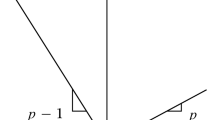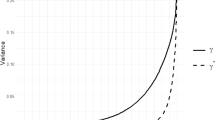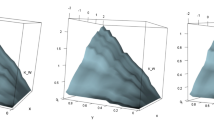Abstract
On the basis of a two-parameter heavy-tailed distribution, we introduce a novel parametric quantile regression model for limited range response variables, which can be very useful in modeling bounded response variables at different levels (quantiles) in the presence of atypical observations. We consider a frequentist approach to perform inferences, and the maximum likelihood method is employed to estimate the model parameters. We also propose a residual analysis to assess departures from model assumptions. Additionally, the local influence method is discussed, and the normal curvature for studying local influence on the maximum likelihood estimates is derived under a specific perturbation scheme. An application to real data is presented to show the usefulness of the new parametric quantile regression model in practice.


Similar content being viewed by others
Notes
An outlying observation, or “outlier”, is one that appears to deviate markedly from other members of the sample in which it occurs.
The voting data were obtained from http://www.onpe.gob.pe, whereas the HDI data were obtained from http://www.pnud.org.pe.
References
Atkinson AC (1985) Plots, transformation and regression: an introduction to graphical methods of diagnostic regression analysis. Oxford University Press, New York
Bayes C, Bazán JL, García C (2012) A new robust regression model for proportions. Bayesian Anal 7:771–796
Bierens H (1994) Topics in advanced econometrics. Cambridge University Press, Cambridge
Bondell HD, Reich BJ, Wang HX (2010) Noncrossing quantile regression curve estimation. Biometrika 97:825–838
Cepeda-Cuervo E, Núñez-Antón V (2013) Spatial double generalized beta regression models. Extensions and application to study quality of education in Colombia. J Educ Behav Stat 38:604–628
Chernozhukov V, Fernandez-Val I, Galichon A (2010) Quantile and probability curves without crossing. Econometrica 78:1093–1125
Cook RD (1986) Assessment of local influence. J R Stat Soc B 48:133–169
Cribari-Neto F, Zeileis A (2010) Beta regression in R. J Stat Softw 34:1–24
Cugerone K, De Michele C (2015) Johnson \(S_B\) as general functional form for raindrop size distribution. Water Resour Res 51:6276–6289
Doornik JA (2009) An object-oriented matrix language—Ox 6. Timberlake Consultants Press, London
Dunn PK, Smyth GK (1996) Randomised quantile residuals. J Comput Graph Stat 5:236–244
Fang KT, Anderson TW (1990) Statistical inference in elliptical contoured and related distributions. Allerton Press, New York
Feng C, Sadeghpour A, Li L (2017) Randomized quantile residuals: an omnibus model diagnostic tool with unified reference distribution. arXiv preprint arXiv:1708.08527
Ferrari SLP, Cribari-Neto F (2004) Beta regression for modeling rates and proportions. J Appl Stat 31:799–815
Flynn MR (2006) Fitting human exposure data with the Johnson \(S_B\) distribution. J Expo Sci Environ Epidemiol 16:56–62
Galvis DM, Bandyopadhyay D, Lachos VH (2014) Augmented mixed beta regression models for periodontal proportion data. Stat Med 33:3759–3771
Gilchrist WG (2000) Stat Model Quantile Funct. Chapman and Hall/CRC, Boca Raton
Hill ID, Hill R, Holder RL (1976) Algorithm AS 99: fitting Johnson curves by moments. J R Stat Soc C 25:180–189
Johnson NL (1949) Systems of frequency curves generated by the methods of translation. Biometrika 36:149–176
Koenker R (2005) Quantile regression, Econometric society monograph series. Cambridge University Press, Cambridge
Koenker R, Bassett G (1978) Regression quantiles. Econometrica 46:33–50
Koenker R, Hallock KF (2001) Quantile regression: an introduction. J Econ Perspect 15:143–156
Kotz S, van Dorp JR (2004) Beyond beta: other continuous families of distributions with bounded support and applications. World Scientific Press, Singapore
Krätschmer V (2007) The uniqueness of extremum estimation. Stat Probab Lett 77:942–951
Kumaraswamy P (1980) A generalized probability density function for double-bounded random processes. J Hydrol 46:79–88
Lange KL, Little RJA, Taylor JMG (1989) Robust statistical modelling using t-distribution. J Am Stat Assoc 84:881–896
Lemonte AJ, Bazán J (2016) New class of Johnson \(S_B\) distributions and its associated regression model for rates and proportions. Biom J 58:727–746
Lucas A (1997) Robustness of the student t based M-estimator. Commun Stat Theory Methods 26:1165–1182
Mage DT (1980) An explicit solution for SB parameters using four percentile points. Technometrics 22:247–251
McCullagh P, Nelder J (1989) Generalized linear models, 2nd edn. Chapman & Hall, London
Mitnik PA, Baek S (2013) The Kumaraswamy distribution: median-dispersion re-parameterizations for regression modeling and simulation-based estimation. Stat Papers 54:177–192
Niermann S (2006) Evolutionary estimation of parameters of Johnson distributions. J Stat Comput Simul 76:185–193
R Core Team (2018) R: A language and environment for statistical computing. R Foundation for Statistical Computing, Vienna
Read CB (2004) A conversation with Norman L. Johnson. Stat Sci 19:544–560
Reich BJ, Bondell HD, Wang HJ (2010) Flexible Bayesian quantile regression for independent and clustered data. Biostatistics 11:337–352
Rousseeuw PJ (1984) Least median of squares regression. J Am Stat Assoc 79:871–880
Simas AB, Barreto-Souza W, Rocha AV (2010) Improved estimators for a general class of beta regression models. Comput Stat Data Anal 54:348–366
Slifker JF, Shapiro SS (1980) The Johnson system: selection and parameter estimation. Technometrics 22:239–246
Smithson M, Shou Y (2017) CDF-quantile distributions for modelling random variables on the unit interval. Br J Math Stat Psychol 70:412–438
Tadikamalla PR, Johnson NL (1982) Systems of frequency curves generated by transformations of logistic variables. Biometrika 69:461–465
Tsionas EG (2001) Likelihood and posterior shapes in Johnson’s \(S_B\) system. Sankhya B 63:3–9
Taylor JMG, Siqueira AL, Weiss RE (1996) The cost of adding parameters to a model. J R Stat Soc B 58:593–607
Yang Y, Wang HJ, He X (2016) Posterior inference in Bayesian quantile regression with asymmetric Laplace likelihood. Int Stat Rev 84:327–344
Wang H, Zhou J, Li Y (2013) Variable selection for censored quantile regression. Stat Sin 23:145–167
Wheeler RE (1980) Quantile estimators of Johnson curve parameters. Biometrika 67:725–728
Zhang P, Qiu Z, Fu Y, Song PXK (2009) Robust transformation mixed-effects models for longitudinal continuous proportional data. Can J Stat 37:266–281
Acknowledgements
The authors would like to express their deepest gratitude to the Associate Editor and the anonymous reviewers for their insightful comments and suggestions that greatly improved this paper. Artur Lemonte was supported by Grant 301808/2016–3 from Conselho Nacional de Desenvolvimento Científico e Tecnológico (CNPq/Brazil). Germán Moreno-Arenas gratefully acknowledges the Mobility Program of the Universidad Industrial de Santander (UIS), Bucaramanga, Colombia.
Author information
Authors and Affiliations
Corresponding author
Additional information
Publisher's Note
Springer Nature remains neutral with regard to jurisdictional claims in published maps and institutional affiliations.
Electronic supplementary material
Below is the link to the electronic supplementary material.
Rights and permissions
About this article
Cite this article
Lemonte, A.J., Moreno-Arenas, G. On a heavy-tailed parametric quantile regression model for limited range response variables. Comput Stat 35, 379–398 (2020). https://doi.org/10.1007/s00180-019-00898-8
Received:
Accepted:
Published:
Issue Date:
DOI: https://doi.org/10.1007/s00180-019-00898-8




